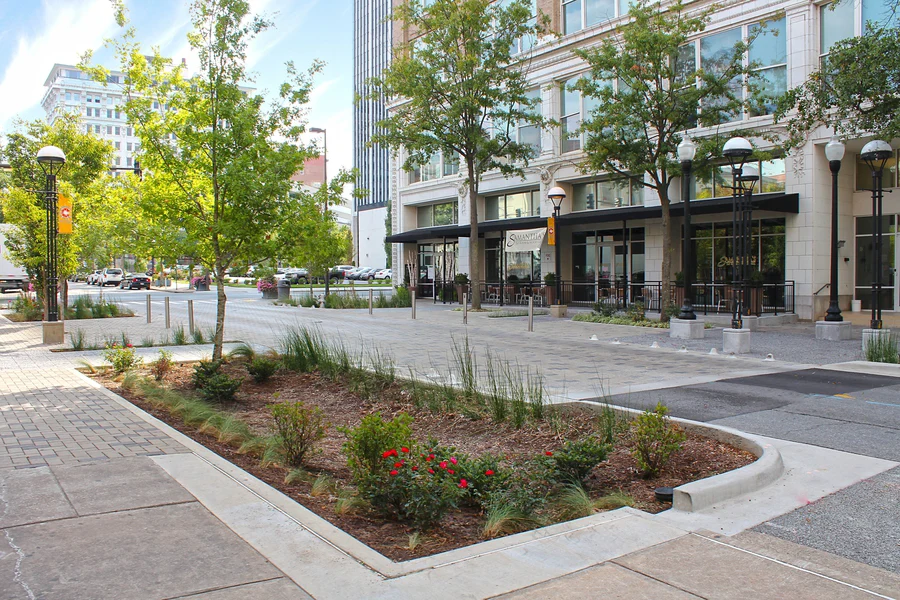
Crafton Tull
Since 1963With many communities looking to implement low impact development (LID) concepts into their urban design, rain gardens and bioretention basins are becoming increasingly popular. One reason for their rise in popularity is their ability to help manage stormwater runoff and to improve downstream water quality.
Rain gardens are shallow, constructed depressions planted with deep-rooted perennial flowers and native vegetation. When strategically located, the gardens capture and soak up rainwater runoff from impervious surfaces such as roofs, streets, driveways, and parking lots. They are typically used in low volume/low velocity runoff situations. Bioretention basins are like rain gardens but are larger and designed to handle a larger volume of stormwater.

For many years, most cities in the Arkansas and Oklahoma region have required stormwater detention facilities to limit the increase in runoff from new developments to predevelopment flows. Cities are now recognizing the importance of not only controlling the volume of stormwater from new developments but also the quality of the stormwater that exits from those developments. Strategically placed rain gardens, bioretention basins, and other LID measures can greatly improve the water quality in downstream creeks, rivers, and lakes.
Placing a rain garden at or directly below the stormwater discharge point of an impervious surface helps to slow down and store the runoff before it enters a nearby street or storm drain. After a heavy storm, rain gardens typically fill with a few inches of rainwater. This rainwater can then filter into the ground, helping to recharge groundwater supplies and aquifers.
Stormwater runoff sometimes carries pollutants from streets, parking lots, and lawns into local streams and bodies of water. By acting as filters for these pollutants, rain gardens and bioretention basins help improve the water quality of local streams, rivers, and lakes; thereby reducing negative impacts to drinking water supplies. Several plant species that are native to the central and eastern United States, when used in rain gardens, can degrade the petroleum products often present in runoff from streets and parking lots. Including:
| Common Name | Binomial Name |
|---|---|
| Switchgrass | Panicum virgatum |
| Canada Wild Rye | Elymus canadensis |
| Bottlebrush Grass | Elymus hystrix |
| Little Bluestem | Schizachyrium scoparium |
| Common rush | Juncus effusus |
Rain gardens also help conserve water by reducing the need for irrigation, and can also serve as an effective method for communities to manage their mosquito populations. A well-designed rain garden will typically drain within 48 hours, which is less than the amount of time required for mosquitoes to complete their breeding cycles. While mosquitoes may lay their eggs in a rain garden, after the stormwater has thoroughly percolated those eggs will not hatch.
Because rain gardens and bioretention basins are designed to allow stormwater to infiltrate, careful attention must be paid to the type of soil and other media installed below the ground surface. Typical soil materials may include a mix of sand, loam, compost, shredded mulch, and filter rock; clay should be avoided, since it does not allow water to infiltrate very easily. A qualified landscape architect or civil engineer should design and specify the soil materials and other substructure of the basin to ensure that stormwater will adequately permeate into the ground. Construction contractors should pay special attention to the design details and material specifications called for by the design professional.
In addition to their practical uses and benefits, the native wildflowers planted in rain gardens and bioretention basins also attract colorful birds and butterflies that create sidewalk appeal for residents and visitors. Beautifying an area often leads to a rise in property values. Native species that can be ideal additions to basins created in the central and eastern United States include:
| Common Name | Binomial Name |
|---|---|
| Black-Eyed Susan | Rudbeckia hirta |
| Purple Coneflower | Echinacea purpurea |
| New England Aster | Symphyotrichum novae-angliae |
| Swamp Milkweed | Asclepias incarnata |
| Butterfly Milkweed | Asclepias tuberosa |
| Great Blue Lobelia | Lobelia siphilitica |
| Cardinal Flower | Lobelia cardinalis |
| Prairie Blazingstar | Liatris spicata |
| Ohio Spiderwort | Tradescantia ohiensis |
In fact, it’s often the multipurpose nature of rain gardens and bioretention basins that makes them a popular solution for many of the issues faced by communities and municipalities. From improving water quality and community aesthetics, to replacing lost habitat for the beneficial insects that our society depends on, rain gardens and bioretention basins can be more economical than other solutions which may only have a singular function.